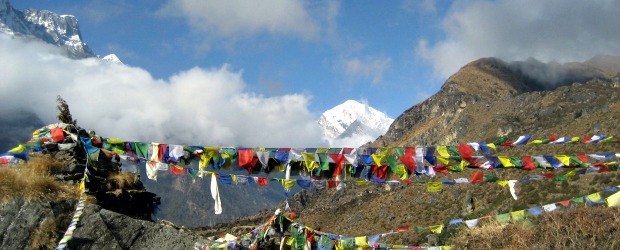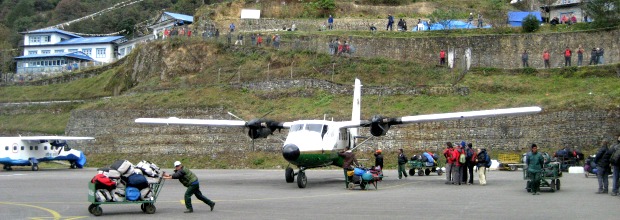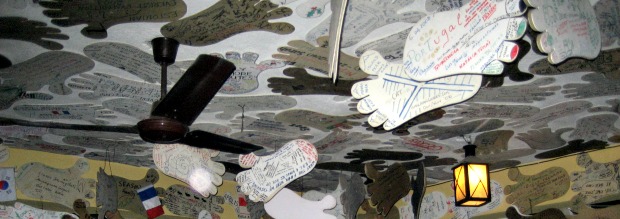You have no items in your cart. Want to get some nice things?
Go shopping
Katmandu sounds like a mythical place. But it is real, busier than London on a Saturday night and more cosmopolitan than Hong Kong. It is a cross-roads, a meeting place and the setting-off point for Everest. Most of the visitors are not climbers, however, but trekkers, those wanting a taste of the hospitality of Nepal, a sight of the unattainable and a chance to breathe the thin air with the locals.
Katmandu airport is chaotic. For new arrivals like us, there is much form completing and document checking; showy bureaucracy masquerading as efficiency. It takes forever but then it’s our first experience of Nepal and we are not inclined to complain. Just being reunited with our bags is a triumph, finding our guide a bonus and meeting the fellow travellers in our group a notable achievement. We leave the airport for a brief sleep at our hotel, struggling through the horrendous traffic that engulfs the town, knowing that we’ll be back in a few hours.
It seems just a blink later – we are in the departure lounge. Our group is heading for Lukla, a tiny airport at the beginning of the Everest trail. Well, no, actually we’re not. Not just yet. We are hanging around, eyeing with envy those who have managed to find a rare seat, occupying ourselves with our guide books and sighing. We are keen to be off but the weather has other ideas. If we don’t leave soon, I will be obliged to face the unpleasant loos.
“Tara Air! Tara Air!”
The tannoy announcement causes a rush of people to the parked buses and we travel out onto the tarmac. A twin otter is waiting for us, sixteen trekkers and a stewardess. She is elegant in an immaculate uniform, a living travel poster. An anomaly. Her role is to hand us a boiled sweet each and some cotton wool for our ears.
“How long have you been waiting to leave?”
“About six hours. How about you?”
“Four days. A bit annoying but there you are.”
We are the lucky ones. Nepal engenders acceptance; these guys would throw a punch if they had to wait even four hours back home. There has been fog; there is no radar here so the pilots have to be able to see for the whole of the 35 minute journey.

We belt up and the passenger alongside me calls the stewardess.
“I’ve only got half a seat-belt.” He points at the ragged remains of his safety equipment.
She shrugs and smiles. If we go down here, it is unlikely a functioning seat-belt would make any difference. Now is not the time to wonder about engine maintenance.
We watch two planes take off and I breathe more quickly. Then disappointment. It’s clear here but fog has returned to Lukla so the airport is closed. We disembark. Back to the terminal, to milky pre-sweetened tea, smelly toilets and sitting on the floor. We doze in uncomfortable positions wedged against the wall, do crosswords and observe each other, a rag-bag collection of nationalities and ages.
“Tara Air! Tara Air!”
We get on the plane again. The fog has gone, but there is frosty air between one of the ground staff and a passenger. He wants to hang on to his enormous back-pack; she wants it in the hold. I really don’t care who wins as long as there is no more delay. This time it happens. Our guide says to sit on the left-hand side of the plane for the best view; there are no pre-assigned seats, of course. We take off noisily and press our faces against the smeared windows.
And there they are, the high mountains hanging from the blue sky like a distant white curtain. Nearer, farms and terraces look like balsa wood models of themselves; broken shoelaces of rivers wind haphazardly between the villages, catching the sunlight with the occasional diamond flash. The hills get steeper and closer, swallowing the little plane. It is noisy even with our ears full of cotton wool, as if the lack of oxygen hurts the engines as much as it will our lungs. We wonder about the landing. Not exactly a worry but in this terrain, an airport seems an unlikely finding.
Then the airstrip appears, a sloping ribbon of tarmac with a dotted line down the middle, 20 metres wide and impossibly short. It is just long enough for the plane to land, a wall of mountain rearing up behind it. There is no room for error; no chance of a second attempt at landing if the first doesn’t work. There is no control tower, no navigation aid. The town squeezes uncomfortably close on the hillside, a jumble of structures crammed together, blue roofs bright in the sunshine. We bump along the ground with buildings almost within touching distance, ears droning until we stop and everyone claps and cheers. The pilot has obviously done this many times and I’m grateful for that. A sign welcomes us to the Tenzing-Hillary Airport in Lukla, built in the 60s with the support of Sir Edmund Hillary. Tenzing’s name was added in 2008, and I smile to see that he has prime position. I later discover that this is rated the most dangerous airport in the world. And the adventure has hardly started.
Six days later, laden with amazing experiences, local trinkets bought at the market in Namche Bazaar and plenty of tales, we face the return trip. Still unaware of Lukla’s reputation, I am excited rather than worried. There is a semblance of security, much activity and scurrying about but little actually being done. We are separated by gender and our baggage examined. I have nothing to hide – but as the enthusiastic but inept woman assigned to me cannot find the zip on my rucksack and gives up on the search, I could be smuggling anything.
Visibility is good so I am hopeful. I try to ignore the booming, incomprehensible tannoy and wait patiently. Presumably, our guide understands the announcements better than I do and will tell us when we need to do anything. The place is packed. Everyone seems to have a different departure time on an assortment of planes and airlines. It is cold. Doors are left open and there is no heating. Calling the area a ‘departure lounge’ is an unnecessary compliment. I dig out a woolly hat and a scarf. Even the closeness of sweaty, unwashed bodies doesn’t generate much heat. We are used to being cold. The lodges along the Everest trail provided us with unheated bedrooms although the beds often had electric blankets, a concession to tourists. Just removing our boots, we got into bed fully clothed with the blankets switched on, an activity that scared us more than landing at Lukla!
The airport is a place for telling stories, relating experiences. How different from the starchily private behaviour of travellers in Europe! Some, like us, have been to the monastery at Tengboche for a clear-sky view of Everest, Nuptse, Lhotse and the pointed Amadablam – a unique panorama that greets the tired trekker as he reaches the end of a long climb and takes away what little breath he has left. The mountains line up against the blue sky, an almost uninterrupted view, a postcard that no-one who hasn’t been there will believe. We arrived in the early morning and enjoyed being almost alone, chatting to the monks who wanted to practise their English and absorbing the peace of the place. Others have been to the Everest Base Camp, a less pleasing sight, (or even site,) if a higher achievement.
There is a story of a broken ankle resulting in an uncomfortable journey down the mountain on the back of a willful donkey, a helicopter rescue and assorted illnesses. Sickness and diarrhoea win most points with headaches close behind, altitude claiming a few victims. Not everyone has tales of woe. I tell about being caught in a ‘yak jam’. These huge beasts have no time for trekkers and dominate the paths. We found ourselves sandwiched between one laden group coming up and another going down the mountain. As a close encounter is dangerous, we retreated to a tree on a small mound in the middle of the path where we were happily ignored.
But it’s not a matter of trying to outdo each other. We are all genuinely interested in each other’s adventures. For a few days, we have all witnessed what life is like for the Nepalese. To say we shared in it is untrue. I could not imagine how I would cope living here, sweeping the step of my unlit room with a bundle of sticks, the doorway covered by a ragged curtain embellished with a swastika – a sign of good luck in Nepal. Or bent double carrying enormous loads as a porter, the daily work of most of the men. We learn that the answer to any question we ask is “Yes” – it is far more positive than “No” – and they are a contented people who want to please.

The first plane due in is late. It apparently had to turn back to Katmandu when it hit mist and this is its second attempt. There is nothing exceptional here, nothing to apologise for; it happens. We know all about it now. I’m getting to be almost relieved that the pilots have the sense to turn back. We discuss what we will do back in Kathmandu. Someone says they are going to Rum Doodle*, a special climbers’ and trekkers’ restaurant. They will sign a piece of card shaped like a Yeti foot, draw their flag and describe their experience. Then it will go on the wall or ceiling with hundreds of others, just ordinary people who want to commemorate what is, for them, an extraordinary adventure. We hear about the most exciting of all, the framed signatures of the summiteers – those special people who have reached the top of Mount Everest. Sir Edmund Hillary is there. Everest summiteers are rewarded with a free meal. That’s a hard-won freebie and one I’ll forego, but I would like my own Yeti foot.
There is the customary cheer when theexpected plane eventually lands. People mill around it, airport staff and tourists alike. As no-one other than the police who guard the airport wears a uniform, it’s impossible to know which is which. In a short time – for this part of the world – we are on board. If anything, this plane is tattier than the one we arrived in, the seats battered, seat belts tangled and frayed and Velcro strips attracting an assortment of debris, their original functions long lost. I cannot guess when it was last cleaned. It was full, as are all the flights. The only other way back to Kathmandu is a long hike, five days at least. Most people are tired; it’s not the most popular option.
Taking off, I admit, gets my heart pumping. As we set off, the runway suddenly stops. We cover its 450 or so metres in no time and then there is just air. The engine roars and we become airborne. We are sailing over a 9000ft cliff. (For some reason, the height is always given in feet!) The passenger alongside me starts to tell stories about fatal crashes on this route. He’d made a point of reading up about Lukla airport. I don’t much like his timing. I console myself with the thought that even with all his research, he still took the flight. Back in England, I discover that everything he said was true.
We land uneventfully at Kathmandu airport. It has now become familiar. I feel at one with these wanderers. End of the adventure, time to go home. Well, not quite. It’s my birthday and I spend it at Rum Doodle, a prayer scarf wrapped around my neck by the waiter, my Yeti foot on the wall.
*The restaurant’s name comes from the fictitious, 40,000 ½ ft high mountain in ‘The Ascent of Rum Doodle’ by WE Bowman.

About Linda Fawke
Linda is an arts person who pursued a scientific career but now has the time to write. She writes fiction, non-fiction and poetry. She has published in various magazines including Berkshire Life and The Oldie, and has been a winner of the Daily Telegraph 'Just Back' travel writing competition and the Litro 'NanoWriMo experience' competition. She has just completed her first novel.

